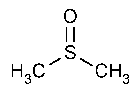Dimethyl Sulfoxide
»Dimethyl Sulfoxide contains not less than 99.9percent of C2H6OS.
Packaging and storage—
Preserve in tight,light-resistant containers.
Identification—
A:
Infrared Absorption á197Fñ,Potassium bromide plates being used.
B:
Add 1.5mLcautiously and dropwise to 2.5mLof hydriodic acid in a test tube cooled in ice.Filter the mixture rapidly,and collect the precipitate.Dry the precipitate in vacuum:a deep violet,crystalline solid is obtained,and it is soluble in chloroform,yielding a red solution.
Specific gravity á841ñ:
between 1.095and 1.101.
Refractive index á831ñ:
between 1.4755and 1.4775.
Acidity—
Dissolve 50.0g in 100mLof water,and add phenolphthalein TS.If the solution remains colorless,titrate with 0.01Nsodium hydroxide until a pink color appears:not more than 5.0mLof 0.01Nsodium hydroxide is consumed.
Water,Method Iá921ñ:
not more than 0.1%.[NOTE—Weigh and transfer the test specimen in an environment of low humidity to minimize absorption of atmospheric water.]
Ultraviolet absorbance—
Maintain Dimethyl Sulfoxide in a water bath at a temperature of less than 20 [NOTE—Do not freeze.],and purge with dry nitrogen for 30minutes.Record the UVabsorption spectrum between 270and 350nm in a 1-cm cell,using water as the blank:the spectrum is smooth with no absorption maxima;the absorbance at 275nm is not more than 0.20,and the absorbance ratios,A285/A275and A295/A275,at the wavelengths indicated by the subscripts,are not more than 0.65and 0.45,respectively.
[NOTE—Do not freeze.],and purge with dry nitrogen for 30minutes.Record the UVabsorption spectrum between 270and 350nm in a 1-cm cell,using water as the blank:the spectrum is smooth with no absorption maxima;the absorbance at 275nm is not more than 0.20,and the absorbance ratios,A285/A275and A295/A275,at the wavelengths indicated by the subscripts,are not more than 0.65and 0.45,respectively.
Substances darkened by potassium hydroxide—
Add 0.5mLof water and 1.0g of solid potassium hydroxide to 25mLof Dimethyl Sulfoxide in a glass-stoppered,50-mLflask.[NOTE—Use only solid potassium hydroxide that is white with no discoloration.]Insert the stopper,and heat in a steam cone for 20minutes.Cool to room temperature:the absorbance of the solution at 350nm,measured in a 2-cm cell,water being used as the blank,does not exceed 0.046.
Limit of dimethyl sulfone—
System suitability solution—
Prepare a solution containing about 0.15mg of dimethyl sulfone per mLand 0.1mg of dibenzyl per mLin Dimethyl Sulfoxide.
Chromatographic system—
The gas chromatograph is equipped with a flame-ionization detector and a suitable recorder,and contains a 3-mm ×1.5-m column packed with 10%liquid phase G25on support S1A(see Chromatography á621ñ).The column temperature is programmed to change at a rate of about 10 per minute from 100
per minute from 100 to 170
to 170 ,the injection port is maintained at a temperature of about 210
,the injection port is maintained at a temperature of about 210 ,and the detector block is maintained at a temperature of about 220
,and the detector block is maintained at a temperature of about 220 .Helium is used as the carrier gas,flowing at the rate of about 30mLper minute.Chromatograph the System suitability solution,and record the peak responses as directed for Procedure:the column efficiency as determined from the dimethyl sulfoxide peak is not less than 1000theoretical plates;and the resolution,R,between the dimethyl sulfone and dibenzyl peaks is not less than 5.0.
.Helium is used as the carrier gas,flowing at the rate of about 30mLper minute.Chromatograph the System suitability solution,and record the peak responses as directed for Procedure:the column efficiency as determined from the dimethyl sulfoxide peak is not less than 1000theoretical plates;and the resolution,R,between the dimethyl sulfone and dibenzyl peaks is not less than 5.0.
Procedure—
Inject about 1µLof Dimethyl Sulfoxide into the gas chromatograph,record the chromatograms,and measure the responses of the peaks:the response of any peak,other than that of dimethyl sulfoxide,is not greater than 0.03%of the total of the responses of all of the peaks;and the total of the responses of all secondary peaks is not greater than 0.1%of the total of the responses of all of the peaks.
Limit of nonvolatile residue—
Evaporate 50g in a rotary evaporator at a pressure of about 30mm of mercury at 95 .Wash the residue from the evaporator flask into a tared dish with several 25-mLportions of glass-distilled methanol,and evaporate on a hot plate in an exhaust hood:the weight of the residue does not exceed 5.0mg.
.Wash the residue from the evaporator flask into a tared dish with several 25-mLportions of glass-distilled methanol,and evaporate on a hot plate in an exhaust hood:the weight of the residue does not exceed 5.0mg.
Auxiliary Information—
Staff Liaison:Lawrence Evans,III,Ph.D.,Scientist
Expert Committee:(PA6)Pharmaceutical Analysis 6
USP28–NF23Page 662
Phone Number:1-301-816-8389
